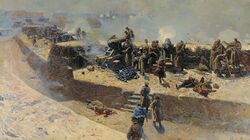Baira Debacle
| Baira Debacle | |||||||
|---|---|---|---|---|---|---|---|
 The Guns of Belziroa, by Orot Jai Remarsna (1891) | |||||||
| |||||||
| Belligerents | |||||||
|
|
| ||||||
| Commanders and leaders | |||||||
|
|
| ||||||
| Strength | |||||||
| 350,000 | 220,500 | ||||||
| Casualties and losses | |||||||
|
18,562 killed 9,624 wounded |
10,417 12,279 wounded | ||||||
The Baira Debacle was a war fought by Txekrikar and the Andamonian First Republic from 1872 to 1875. Provoked by the Andamonian government, Txekrikar declared war against Andamonia to defend its honour but found itself initially overmatched. A number of large battles and sieges followed, but Andamonia's initial conquests were driven back to east of the Baira and by 1875 both sides agreed to a return to the status quo.
The war developed out of a campaign promise by Muriaz Raihanri, the successful candidate in Andamonia's 1871 presidential election. He pledged to annex Reu and the Usma lands east of the Baira, home to a considerable ethnic Andamonian population, but after his election was unwilling to begin an unprovoked war with an amicable neighbour. His government gradually impinged on Txekrikar, finally provoking its prince to declare war on Andamonia in July 1872.
Andamonian forces quickly occupied the eastern Usmalím and crossed the Baira, but failed to take Reu, their main objective. The republic's navy attempted to move in to support its army, but struggled to pass the chokepoint of the Halsa Strait, guarded by the Txekri fortress of Belziroa. In April 1873, a battery of artillery was set up across the strait with some twenty-eight howitzers to bombard the fortress into submission from six kilometres distant. Even faced with the combined firepower of that battery and the Andamonian navy, Belziroa continued to resist and return fire, and after weeks of bombardment a daring raid by Txekri horsemen destroyed the howitzers and the siege was reluctantly abandoned. Inspired by an unexpected victory, Txekri forces renewed their resistance and drove the occupying force out of the Usmalím by October of that year. Fighting continued sporadically through 1874, with neighbouring powers attempting to negotiate an end to the conflict. The two sides eventually signed an armistice on 4 February 1875.
